Search Results for 'traders'
Trading Lessons & Worden TeleChart
In my previous post, I discussed the importance of learning from our trading mistakes to become better traders, citing one way we learn at TheStockBandit.com is through the Trade of the Week lesson. In this post, I want to show you a way to learn more from trades of your past – by keeping them separate and tracking them in TeleChart.
I’ve been a user of TeleChart since 1999, and I’ve never regretted paying for this great product. I talk a lot about the importance of using a charting program if you’re an active trader (an absolute MUST!), so I’ll leave that for another discussion (even though I still believe it!). What I want to point out here is how to use TeleChart to learn from your past trades, so let’s get to it.
Learning From Others
At 7pm ET after every market close, I do one last update of TeleChart for the final end-of-day data. I use their real-time charting service, called Platinum (find me on TCNet anytime, I’m TheStockBandit), so when the market closes I already have the ending numbers for the day. However, there are occasional minor changes in data from the exchanges after the closing bell, so the 7pm update includes the official closing levels and volume totals.
The 7pm update also includes an incredibly underrated feature – The Worden Report from Don Worden. Don has been in the market for many decades, and his trading experience is most likely greater than yours and mine put together. His nightly report alone is worth the price of their software, and I rarely miss his posts to see how he is viewing the current market conditions. In addition to his post, there are often trading lessons provided via submitted notes from other TeleChart users to Don, along with his response to them. While many of these contain over-complicated formulas for locating trade ideas which I ignore, there are some real gems that show up when other traders share their own trading lessons.
One recent idea was submitted by Sir Fertile Sources, who suggested something revolutionary yet unbelievably simple: create a separate watch list for stocks you have sold! Soon after, Sir Major Lessons added another layer to the idea by creating separate “sold” watch lists depending on the conditions which generated the sale (abysmal loser, stop loss hit, stop loss hit for a gain, booked substantial gain). The idea is to be able to quickly review those stocks which you have held and see not just how they are doing now but also how you may have improved upon your exit.
TeleChart Notes
The Notes feature in TeleChart is highly underrated. Pull up any chart on any timeframe within TeleChart and click ‘N’ on the keyboard. A dialogue box pops up with an instant capture of the chart as it looks right now. Enter your thoughts (the note) and click ‘OK’. You’ve just made a note which will forever be tied to the current chart view, allowing you to return at any later date and review your note. This is perfect for the “sold” watch list…..once you’ve sold your stock, simply enter a note, save it and move on. Later when you want to review it, you’ll see exactly what you saw when you made your sale, giving you an instant visual comparison to the current chart.
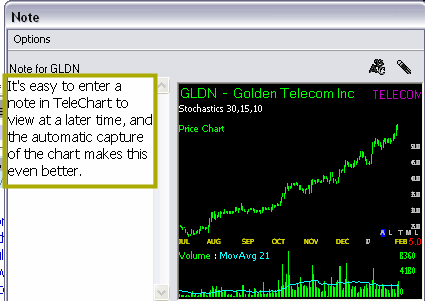 Notes are a one-click feature of TeleChart, allowing you to capture the chart and store your thoughts along with it. (The actual window can of course be resized).
Notes are a one-click feature of TeleChart, allowing you to capture the chart and store your thoughts along with it. (The actual window can of course be resized).WatchList Tracking
The WatchList Tracking feature of TeleChart is often overlooked. This is an excellent way to track a portfolio or even just a WatchList such as the “sold” WatchList. WatchList tracking will do exactly what it says – track every individual component in the list and even provide averages for things like percent change and number of days. This is ideal for the “Sold” WatchList, as the program will immediately and automatically begin to track your old stocks and you’ll be able to pull them up at a glance at any later date to see how well or poorly they have performed since your exit.
Keeping it Simple
Every trader who is looking to improve can find great lessons in trades of the past. Trading can get real complicated if you let it, so take the easy approach to improvement when you have the chance. This new learning approach is already simplifying how I review my trades, letting me get to the application of lessons much faster. I hope it works for you just as well!
Take a free 30-day trial of TeleChart 2007 and see what it can do for your trading. I did, and I’m still using it 8 years later.
Jeff White
President, The Stock Bandit, Inc.
www.TheStockBandit.com
[tags]Stock Market, Investing, Stock Trading, Stock Charts, Chart Patterns, TeleChart, Worden[/tags]
Learning From Trading Mistakes
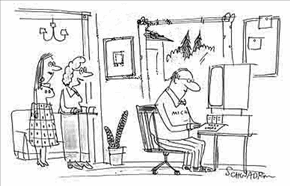
Bob trades online so his dumb mistakes remain anonymous.
While I’m not a backtester, I do believe that we can learn a lot as traders by reviewing our trades of the past. After all, if we can’t learn from our mistakes, how can we learn at all?
The member area of TheStockBandit.com has a feature called “Trade of the Week”. It’s a useful area that a lot of members comment on due to the lessons taught there. The T.O.W. is a look back at a trade I took each week and how it turned out. Some of them work beautifully and I get to brag a little, but the ones that we all learn from the most (myself included) are the losing trades which are dissected after the fact.
JAH is one trade I recently featured, which was a channeling stock I took for a short sale at an area of resistance. My stop loss level was close by and the stock had bounced on diminishing volume right up to the upper channel line. I went short, but the stock soon after broke above the trend line, triggering my buy stop to take me out of the trade for a small loss.
After examining the trade closely, I determined that if I were given the same setup again, I’d trade it again the same way. I just like these setups because in every case my risk is quantified with a good potential reward, and that’s the cornerstone of how I trade. However, in this case I was objective and this was one trade in which my timing was simply off. Sometimes the lessons are minor, but being willing to take something away from a closed trade is the mentality we need.
It always surprises me how even selecting just one trade per week to examine more closely helps me learn and apply that lesson better going forward. Over the course of a year, I end up being a lot smarter as a trader.
What are you doing to learn from your trading mistakes? In my next post, I’ll show you a great way to learn from your past trades which is so simple you won’t believe it.
Until then, trade well!
Jeff White
President, The Stock Bandit, Inc.
www.TheStockBandit.com
[tags]Stock Market, Trading Profits, Profit Targets, Stock Trading[/tags]
Book Review: Anatomy of the Bear
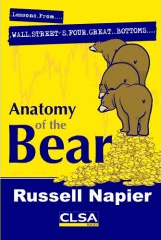 I love to read trading books, so when I was asked to review Russell Napier’s book, Anatomy of the Bear, I happily obliged.
I love to read trading books, so when I was asked to review Russell Napier’s book, Anatomy of the Bear, I happily obliged.
In the book, Napier examines 4 major bear market bottoms on Wall St., with a portion of the book devoted to each of the major lows created in 1921, 1932, 1949 and 1982. Napier looks at the history of these bear markets, the events leading up to them, and how the investors of those times were impacted throughout the bottoming process. In his research, he examined some 70,000 articles from the Wall Street Journal from the two months before and after the final lows were made, adding some valuable perspectives from the media and traders of the day. These article tidbits give some great insights into life in the trading trenches at the time, which is incredibly helpful in painting the picture of the doom and gloom which ultimately accompanies a lasting market bottom.
Napier also takes the reader back to the situations of each of the major lows, essentially transporting you to the time and the events which led up to the bear phases. He examines wars, monetary policy, politics, economic factors, and anything else which had an impact on the buying and selling motivations of traders, making this book an incredible resource for anyone wanting to learn from lessons of the past.
Here are a few things I found noteworthy:
* Earnings Trailed Price. In the 1921 bottom, price found a low about 4 months before earnings found a bottom. Earnings bottomed some 5 months after price bottomed in the 1932 bottom. That makes for some interesting fundamental vs. technical discussion! (You know which side I’m on)
* Short Interest Stayed High After Lows. Napier discovered that short interest remained rather high even after price made a low, serving as a good reminder that even bears get greedy. In turn, as the shorts end up having to buy to exit their positions, it propels prices even higher, perpetuating the newfound momentum. Napier notes that a large short interest combined with a market that didn’t decline on bad news was an excellent signal in the 1921, 1932 and 1949 lows.
* Bear Markets Don’t Scare You Out. The results of Napier’s research flies somewhat in the face of theories which indicate that capitulation marks a lasting low, revealing instead that bear markets typically end with a final decline on no volume. Essentially, bear markets wear you out, not scare you out.
* Commodities Count. The end of commodity price declines also marked all 4 major equity lows, with copper playing a prominent role as it preceded or coincided with every equity rebound.
The book also ends with a great number of strategic and tactical conclusions drawn from the study of these 4 great bear markets – plenty of reason alone to check out this book.
Thanks to Russell Napier for the chance to review this fine study of the past, I enjoyed the read and learned a great deal from the bear markets of the past.
Jeff White
President, The Stock Bandit, Inc.
www.TheStockBandit.com
[tags]Stock Market Books, Bear Market, Stock Market Lows, Russell Napier[/tags]
Day Trading: The CNBC Debate
As I watched CNBC’s clip on the return of day trading Friday, I was entertained by the banter. On one side was Trey Robinson, an acquaintance of mine from CyberTrader who just happens to be the Director of Business Development (who would possibly know more about the scope of traders in the market today?). On the other side of the argument was Michael Farr, a long-term portfolio manager who clearly knows very little about day traders being that he only deals with buy-and-hope hold investors.
Day Trading Differently
Trey discussed the higher net-worth clients that are accounting for the increased level of day trading in recent months (there has been a lot of buzz lately regarding this), and it’s not surprising to hear that much of today’s trading crowd is notably different than the bubble crowd of several years ago.
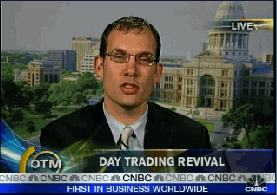 Trey Robinson of CyberTrader discusses today’s day trader on CNBC. (Click image to launch video)
Trey Robinson of CyberTrader discusses today’s day trader on CNBC. (Click image to launch video)By taking a portion of their portfolio to day trade, the new crowd is able to diversify their timeframe rather than just attempt to match the market’s returns over time. They’re also using sophisticated tools to help execute their trading strategy while reducing risk. Truly a sophisticated new breed of day traders, no doubt.
Long-Term Investing Contradictions
As Michael started to speak about day traders, he wasted little time before jumping right to unfounded claims such as “these people are speculating and not investing,” and that “when the music stops, it’s over.” He also added that “when the general trend turns down, these people don’t make money.”
How ironic! He failed to mention that a long-term investor such as himself can indeed suffer considerable losses during a market correction, especially considering how few are hedged or short selling the way most day traders do. It’s also interesting to note that his long-term investors can be at greater risk than a day trader during a downturn, especially considering that they are mostly invested at all times and a day trader can take a position in cash (thereby preserving capital, not losing it).
Michael also failed to mention that even long-term investing also involves a level of speculation. After all, what guarantee does any investor have that his choice of investment (whether day trading or long-term investing) will produce a profit as expected? There are no guarantees in the stock market, regardless of timeframe.
Day Trading Reduces Exposure to Risk
On Friday at TheStockBandit.com, some members and I were discussing on my trading blog the sizeable downside gap in HAR after the company had reported earnings. Interestingly, a day trader would have had no exposure to the risk of an earnings gap which occurs overnight, but the long-term “investor” would have felt the full sting.
Same thing for the incredible downside market gap which followed 9/11: no harm to the pure day traders, but long-term investors needed considerable time to recover.
It’s pretty clear that even long-term investing involves significant risk (geopolitical event risk, earnings gaps, analyst downgrades, etc.), but one can easily argue that day trading reduces the exposure to risk due to the limited holding periods. Who can disagree with that?
Jeff White
President, The Stock Bandit, Inc.
www.TheStockBandit.com
[tags]Stock Trading, Day Trading, CNBC, Stock Market[/tags]
Potential Market Shifts
As traders, we always have to stay aware of our surroundings. Ideally, we’re seeking to maintain an edge on our competition, and that means trying to determine with some degree of accuracy what may happen next.
I’m no fortune-teller and I never make market predictions, so instead I constantly ask a handful of questions regarding the market’s behavior. With last week’s failed breakout fresh on my mind, I’m watching for potential market shifts just in case. This may only be some temporary weakness, or it may be a warning that something bigger is on the horizon – it’s just too early to know for sure yet. What we CAN do is to gauge the character of the market, and that’s what I’ll be focused on this week.
Check out this week’s Free Newsletter at TheStockBandit.com where I discuss 4 factors I use to determine market strength when watching for potential market shifts. And when you do, make up your own mind whether or not the bull in the picture looks safe!
By the way, you can sign up for the free newsletter on the Free Newsletter page at TheStockBandit.com. An opt-in form is provided at the top of the page which puts you in full control of your email subscription at all times.
Trade well out there this week!
Jeff White
President, The Stock Bandit, Inc.
www.TheStockBandit.com
Trend Lines Often Need Adjustments
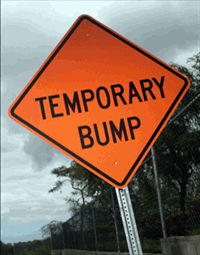 Technical analysis offers a number or tools and indicators to apply to charts in order to better determine buy and sell areas. Some traders have hard-and-fast rules regarding their analysis tools (and I’m a big proponent of having trading rules in place), but there are parts of technical analysis which do require some ongoing flexibility.
Technical analysis offers a number or tools and indicators to apply to charts in order to better determine buy and sell areas. Some traders have hard-and-fast rules regarding their analysis tools (and I’m a big proponent of having trading rules in place), but there are parts of technical analysis which do require some ongoing flexibility.
Trend lines are the tool I use the most in my trading and charting, and they definitely require keeping an open mind. Drawing trend lines and trading effectively with them is certainly more of an art than a science, because they can morph over time. While a trend line can be defined as a straight line connecting at least two relative highs or relative lows, what’s often left off of the description is that they frequently need to be refined.
The first time I draw a trend line, I usually consider it to be a rough draft. That means I’m willing to adjust it slightly as the chart pattern begins to mature and time goes by. The more times that price bars touch a trend line, the more valid it becomes. However, not every break of a trend line leads to another meaningful move in price. Therefore, if price pierces the trend line slightly but there’s no change of character in the underlying stock (or index or futures), that’s my signal that the break is of less significance and I’ll likely need to adjust my trend lines.
My aim is not to be perfect the first time I set a trend line. What I want is to have something valid I can trade from, as that will not only increase my confidence in the trade but also my profitability over time.
Technical analysis tools exist to help us, not bind us as traders! Trend lines are usually a work in progress and therefore rarely set in stone. Keep this in mind if you use them in your trading, and try to be sure that something meaningful is occurring when you see a trend line being broken. If the volume is up or the momentum is building, you can take the trade with much greater confidence.
Jeff White
President, The Stock Bandit, Inc.
www.TheStockBandit.com
3 Signs You’re Trading Too Big
Are You Trading Too Big?
The market tends to expose our every weakness. Whether it’s emotional extremes, a lack of preparation, or simply being stubborn, trading will reveal your Achilles’ heel!
One common mistake we all make from time to time is trading too large of a position. This may be the case when an account is too small, or it may be a product of the market you’re trading and whether or not there’s ample liquidity to allow for entries and exits with minimal slippage. Sometimes trading too big can mean trading your normal size in an overly-erratic market. While there are several factors involved in trading too large for your own good, focusing on realizing when you’re trading too large can be quite helpful.
Here are 3 clues that you’re trading too big:
If you’re adding on trading size because you’re on the wrong side of a trade, you’re trading too big. Why add fuel to the fire when you’re wrong? It costs money and you’ll often come out of the other side of the trade not knowing which way is up! Compounding one mistake with another will often lead to even worse performance, so focus on working your way out of the first bad trade without adding to it.
If you can’t sleep at night, you’re trading too big. The phrase “sell down to the sleeping point” is often used but for good reason. If you walk away from your screens at the end of the day and all you can think about is the trade you’re in, then it probably means too much to you. Lighten up on your position, and you’ll usually find greater clarity which leads to profitable decisions.
If you are acting like a baby, you’re trading too big. Screaming at monitors, smashing keyboards, and banging on your desk is for toddlers, not traders. If you’re not acting rationally, then it’s time to cut down that trading size. I’ve been on a number of trading floors and witnessed this behavior, as well as been guilty of some of it myself. Such actions indicate that emotion is in the driver’s seat rather than logic, and that’s a huge disadvantage in trading. Trading plans should be in place to direct your next move, but how can anyone follow a logical plan when they’re busy throwing a temper tantrum? I don’t ever recall my own or anyone else’s childish behavior leading to a good day or rescuing a bad one! If this sounds like you lately, take a breath, lighten up on that position size, and get back to your game plan.
Position sizes should be increased when you’re trading well, not struggling. Cutting down position sizes during times of frustration will allow you to get your confidence back and find some clarity.
Wait for your mojo to return before you step back up to full size, and while you wait, focus on trading well rather than P&L!
Jeff White
President, The Stock Bandit, Inc.
www.TheStockBandit.com





